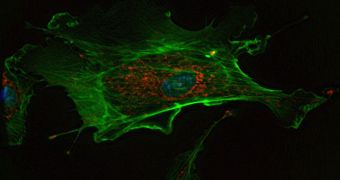In a new scientific study, experts were able to create a new type of particle, that could be used in the near future as a marker for highlighting cancerous cells in the body, and making them more clearly visible on X-ray images.
This so-called tumor “magnet” basically consists of a specific amount of tiny particles, which are injected into the body. Once in the bloodstream, they seek out cancerous cells and tumors, and affix themselves to their surface.
The protein that is being targeted with the new approach can be found in only two places throughout the human body. One location is the reproductive system, and the other is the blood vessels that fuel cancer cells and tumors.
Mount Sinai School of Medicine in New York assistant professor Aurelian Radu, a researcher on the new investigation, says that the key to finding cancer is detecting the type of tumor the patient has.
“It's in all the tumor types, in all the patients we examined,” the expert explains. The target for the new particle is a protein called the FSH receptor.
This research was carried out by Radu, together with French scientists from the National Institute of Health and Medical Research. The team analyzed some 11 types of cancer tumors affecting about 1,300 people.
Some of the most common forms of cancer included in the research are prostate, colon, breast, ovaries, lung and liver cancers, LiveScience reports. Radu says the FSH protein was present in each tumor.
Once the common element was identified, the team moved on to the next stage of their work, which was to develop a method of tagging FSH, so that it becomes visible under X-rays.
Using unsuspecting lab mice, the experts were able to synthesize a special molecule, which targeted the protein specifically. This molecule was then attached to gold nanoparticles, which shine under radiation, indicating the exact location of cancer cells.
“Although we don't know the mechanisms why this marker appears, it's likely it's evolved because of the need of the tumor to grow blood vessels to get nourishment,” Radu explains.
In the paper detailing the findings, which appears in the October 21 issue of The New England Journal of Medicine, the expert adds that his group now plans to check if the study can be applied to humans as well.
If so, this could mean a great leap forward in cancer detection, which could in turn help save thousands of lives every single year.

 14 DAY TRIAL //
14 DAY TRIAL //